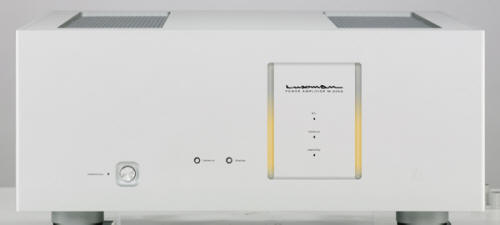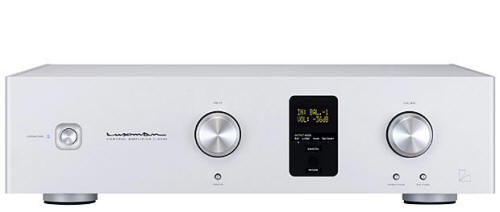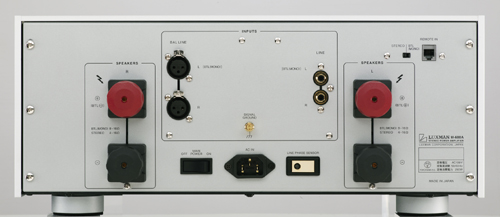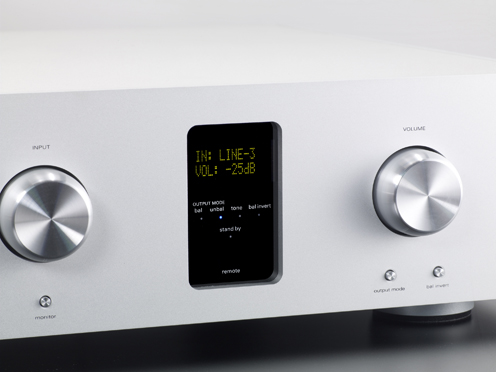
You are reading the older HTML site
Positive Feedback ISSUE
march/april 2008
luxman
M-600A amplifier and the C-600f preamplifier
as reviewed by Mike Wechsberg

|
MIKE WECHSBERG'S SYSTEM
LOUDSPEAKERS
ELECTRONICS
SOURCES
CABLES
|
If you read much of the audio press you've probably heard lately about Luxman components. Luxman, from Japan, had an excellent reputation in the US and around the world in the 1970s and 1980s for very musical sounding gear. They disappeared from these shores for a number of years due to some corporate re-structuring. However, they have returned with gusto and an expanding set of amplifiers, preamps, CD players and other items. I was privileged to be one of the first in the nation to hear the new C-600f control amplifier and the M-600A Class A power amp, a continuation of Luxman's 80th Anniversary Commemorative edition of components. These are moderately priced ($8500 each, alas that is moderate in today's age) but directly descended from their more expensive brethren that have received glowing reviews around the world, especially in Japan. For those of us who can't afford to dabble in the $10K and up range of components, this new set of Luxman amplification gear provides an opportunity to touch the stars without having to be one to afford the privilege.
Description
The M-600A stereo amplifier is a pure solid-state Class A design that puts out 30 watts per channel into 8 ohms. The power increases inversely proportional to the speaker impedance to a rating of 120 watts into 2 ohms for those difficult speaker loads. The amplifier can also be bridged for monoblock operation with a mere flick of a switch on the back to further double the power. Because its bridged operation, the power output quadruples, hence a stereo amplifier putting out 30 watts @ 8 ohms, puts out 120 watts @ ohms as a bridged monoblock. So even though this amplifier starts out with what sounds like a fairly puny 30 watts per channel it is really a massively powerful amplifier, and it has the size and weight to match. I don't actually know how much the amp weighs because I can't read the manual, which is written in Japanese, but this baby is heavy. The chassis is a gorgeously finished aluminum with all rounded edges that just oozes quality. It sports both balanced and unbalanced inputs, and very sturdy speaker binding posts that will support the heftiest of speaker cables. In a nice touch the amplifier comes with plastic caps to cover all the inputs to protect them from dirt and corrosion. The thick front panel is also gorgeous and has a front panel lighted on-off switch and two other small buttons; one that selects between the balanced and unbalanced inputs and a second that dims the display.
Other Luxman amplifiers have the classic analog VU meters on the front to indicate power output, however the M-600A uses a pair of vertical bar displays that depict power in a logarithmic fashion by the height of the bar. Although not as fascinating to watch as the VU meters, this display is probably faster and more accurate (there is no calibrated scale on the bars). My taste leads more in favor of VU meters, but then I used to be a pot jockey at my college radio station (i.e., pot as in "potentiometer", not the other kind).
Most Class A amplifiers have massive heat sinks to dissipate the higher than average thermal output of this type of amplifier. The M-600A hides these often ugly monstrosities inside the chassis. The amplifier does put out a large amount of heat when driven heavily so don't plan on placing anything on top of them (my cat learned this the hard way). Large feet support the amplifier about an inch above its shelf as part of the thermal management system, and should also not be obstructed. The inside construction is impeccable with very high quality parts all around. The design employs a number of technical features that are unique to Luxman and are best read about on their web site. One unusual feature is the use of a classic U-shaped transformer instead of the toroidal transformer almost ubiquitous in other components today. Luxman use an E-I transformer, which Luxman have been using now for over eighty years. They prefer the quality of the bass they get from the E-I, rather than say toroidal. Luxman is a pioneer in transformer technology and have been winding their own for decades. Overall the M-600A has an understated appearance, but makes a definite statement of quality that its owner can be proud of.

The matching C-600f has a similar understated appearance with a chassis finished the same as the power amp and, although not as heavy, the preamp is also quite a stout piece of equipment. It has just two control knobs, three small buttons and a small display area on its front panel in addition to a hefty power switch. One knob selects the input and the second controls volume and both have a very smooth feel fitting for a piece of equipment in this price range. The three buttons control the tape monitor and whether the balanced or unbalanced inputs are selected. The third button inverts the phase of the balanced output. I'm sure the circuitry behind these knobs and buttons has the typical Luxman quality imprimatur. The simple yet sturdy remote control repeats the front panel functions and also includes control of the Luxman tone controls. Yes, this preamp has tone controls, an unusual feature in audiophile gear, but a very useful one if your musical listening extends beyond audiophile-endorsed recordings or if you must cope with a listening room unadorned with rampant acoustic treatments. The black display area on the C-600f front panel indicates volume setting, selected input, whether the tone controls are in or out, and whether the balanced or unbalanced outputs are being used.
The rear panel of the C-600f is very impressive. Like the power amp, the unit comes with covers for all the inputs and outputs. There are five unbalanced line inputs and two balanced line inputs. The C-600f does not have a phono preamp (grrrrr!), an omission that significantly detracts from the value of this component. However, it does provide the user the opportunity to exercise their own taste in phono amplification. The preamp also has 2 pairs of outputs that can either be balanced or unbalanced (or both). Everything about this preamp exudes quality befitting of its price. This applies to the sound as well as we will see.
Set Up
Both components were brand new out of the box when I received them so I used them for a couple of weeks before beginning serious listening. I was alerted that the preamp in particular has a long break in requirement so I kept it powered up and running for several days straight while I was away on business. After break-in both components sound very good after power-up although the top end smoothes out a little bit after about 30 minutes of playing. I used the M-600A and C-600f together and also separately with my Audible Illusions III preamp and Krell KAV-250 power amplifier. Speakers were the Vivid Audio K1s reviewed in PFO Issue 35 and my personal Wilson Cubs. Interconnects were single-ended Audioquest and MIT. Towards the end of the review period I borrowed some Nordost Valhalla balanced interconnects to check out the balanced mode of operation. Since the C-600f has no phono preamp the exclusive source component I used was the excellent Luxman DU-80 Universal Player reviewed in PFO Issue 34.

M-600A Zounds!
The easy part of this review is writing about the sound of the M-600A. It is fantastic! This is a wonderfully musical amplifier that brings music to life. Voices are full and rich and sound like they are emanating from a real person instead of a paper cone and a bunch of glue. The detail from small ensembles or rock bands is all that audiophiles hope for, and the majesty of the large orchestra is both felt and heard. Dynamics are great including the very low level dynamics experienced at quiet listening levels. The highs are wonderfully clear and transparent and allow instruments to stand on their own even when immersed in a sea of others. The midrange is neutral and full-bodied like a good tube amplifier. Bass is strong and dynamic and bass definition is outstanding down to the frequencies I was able to test (the Vivids only go down to about 40Hz and the Wilsons down to 50Hz). Images were wide and deep when the recording called for it. Compared to my stock system, the M-600A let me hear considerably more inner detail and allowed me to delve much more deeply into the music. On the other hand, when I just wanted to sit back and enjoy, this amplifier set my toes tapping and my head bobbing and other parts of the anatomy moving in all kinds of different directions. If you think I enjoyed my time with this Luxman you are right!
The M-600A got the best that was possible out of both sets of speakers I tried. It let me hear all that is splendid about the Vivid K1speakers including startling images that never seemed connected to the speakers themselves. On the Wilson Cubs, which aren't as revealing as the Vivids, the Luxman allowed me to enjoy the music more than I ever have before. The Luxman amplifier also sounded good with both preamps I used. The M-600A is clearly designed to be used with the companion C-600f control amplifier. They are voiced in a very similar way and the electrical interfaces are closely matched. I'll talk more about their sound together below. When I fronted the M-600A with the tubed Audible Illusions III I also heard a golden sound but somewhat darker (characteristic of the Audible Illusions). The combination of Audible Illusions and Luxman electronics provides a soundscape with huge depth that is revealed in distinct layers. The characteristics of different concert halls are easy to hear and the air around individual instruments is palpable. Upbeat music is very infectious with this combination and it is easy to get lost in the music (a very desirable property). The only thing missing is the detail and purity in the highs, but this returned when the M-600A is matched to the Luxman C-600f.

Although the Luxman amp is rated at a modest 30-watts into 8 ohms it seems to be much more powerful. Of course the Wilson's have a rated impedance of 4 ohms so the Luxman should be able to produce more than 60-watts into this load. The Vivid K1s are specified as 6 ohms which translates into a 45-watts output for the Luxman. I never heard any strain on either speaker, even on sharp transients played full out in my moderate sized listening room. Playing complex orchestral pieces or multiple synthesizers at high levels did not cause a hint of a problem. Sometimes the front panel bar displays got pretty close to the top but the amp did not complain. It did get pretty hot however so make sure you allow plenty of ventilation around this beauty. In summary, I rate the M-600A a complete success. Unless you have very inefficient speakers or a very large room it's hard to imagine needing more power. Most amplifiers aspire to be Class A because of the low distortion and purity this allows, but many designers shy away because of the extra cost and difficulty of achieving high power operation. Luxman has managed to produce an amplifier with all the positive attributes of Class A in an attractive and affordable package. This wonderful amplifier is worthy of your audition if shopping any where near the $8500 price range or above.
C-600f Control Amplifier
Describing the sonics of the C-600f is more complex than for the M-600A. Like the power amp, the preamp is a wonderful unit that sounds very alive and dynamic with vanishingly low distortion and excellent transparency that might be as good as anything else out there today. The lows reach as low as the other system components can go and the highs are crystal clear and very extended. The midrange is neutral and musical and images jump out of the plane of the speakers. It was easy to enjoy music played through this preamp and its detail allowed it to be used as a tool to assess recordings, sources or other components. There were a couple of characteristics of this preamp that, at first, gave me some pause. I noticed that the midrange was not as full bodied as with my tubed reference, and spatially the C-600f moved the soundstage slightly forward and foreshortened depth in some recordings. This was evident with both amplifiers and speakers I used in my auditions. However, I could not be sure whether this was characteristic of the preamp or had something to do with cables and system matching. I decided to see whether this sonic signature remained the same through the balanced connections. Luxman distributor Philip O'Hanlon kindly loaned me a set of Nordost Valhalla balanced interconnects to run between the preamp and the amplifier (both the Krell and Luxman amps have balanced inputs). This cable change immediately brought the midrange fullness up to standard and enhanced image depth as well. Both female and male vocalists took on that extra "oompf" that it takes to become completely involved in the music. Large jazz bands and classical orchestras became even more exciting and there was a slight but noticeable improvement in treble detail as well. In balanced mode, the C-600f exceeded the performance of the Audible Illusions in every way except perhaps for layering of the sonic image. It's hard to say whether this improvement derives from going to balanced from single ended or from going to a $3000 cable from a $500 one. Could be either one. I do get wonderful image depth and midrange fullness using the single-ended cable between my stock Audible Illusions preamp and the Krell amplifier so the preamp has something to do with it. One other small point, when in balanced mode the power indicators on the M-600A amplifier stopped working. I don't know if this is intentional or something funny with the setup but without a readable manual I couldn't find an answer.

The tone controls are a unique and useful feature of the C-600f. When set flat I was never able to hear any difference in switching them in or out (the sound is muted for about a second whenever the tone control switch on the remote is pressed). This is a brilliant achievement (I wager someone out there with better cables or speakers can hear the difference, but for most people that difference will be inconsequential). However, the tone controls can be used effectively to improve the sound of problem recordings or room issues. For example, in my room the Vivid speakers have a distinct hump around 60Hz due to a room mode. This gives a one-note bass sound on some recordings but is effectively tamed with the Luxman bass tone control. I was also able to clean up some poorly recorded strings with a touch of the treble control. I never found reason to go more than three clicks in any direction yet I had quite a lot of fun with the tone controls. I'll miss them quite a bit.
My small quibbles on the C-600f sound should not deter you from giving the preamp an audition. It made wonderful music that was both fun and illuminating to listen to. The volume control and source selector worked with the precision one would expect from an $8500 preamp and the tone controls are a great feature. Sure wish it had a phono preamp though. Expect to do some experimentation with cables before settling in but by all means put this preamp on your short list for a listen. It stands proudly with the other fine gear that Luxman is now making.
Final Thoughts
The Luxman M-600A is an unqualified success that you should definitely audition if shopping for an amplifier. It looks beautiful yet conservative on the shelf but really lights up when you hit the power button. The quality inside and out promise years of enjoyment. The same can be said for the matching C-600f control amplifier. It is the equal of the amplifier in sonic excellence, but requires some care in cable matching and maybe other tweaks. I guarantee the tone controls will add to your musical enjoyment. Highly recommended. Mike Wechsberg
C-600f preamplifier
Retail: $8500
M-600A amplifier
Retail: $8500
US Distributor:
On a Higher Note
web address:
www.onahighernote.com
TEL: 949. 488. 3004
